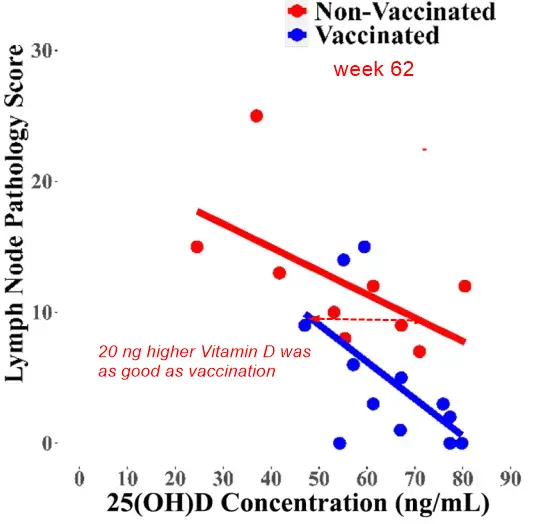Vaccination protected as much as 20 ng higher vitamin D (calves in this case)
Mycobacterium bovis vaccination and subsequent experimental infection outcomes are associated with changes in vitamin D status in dairy calves
JDS Commun. 2024 May 10;5(6):622-627. doi: 10.3168/jdsc.2024-0547
Rachel L Lee 1, Kieran G Meade 2, Shelley G Rhodes 3, Tom Ford 4, Ilias Kyriazakis 1

Investigations into the role of vitamin D (vitD) in the immune response of cattle are limited. The objectives of this study were therefore to investigate the association between circulating vitD concentration, tuberculosis (TB) vaccination, and Mycobacterium bovis infection outcomes in 24 dairy calves (<8 wk old) that were housed throughout and fed a BW-based allowance. The study design incorporated 2 phases: vaccination (experimental wk 0-52) and experimental infection phase (wk 52-65). Vaccinated calves (n = 12) received a subcutaneous injection of a live attenuated TB strain at wk 0, whereas unvaccinated ones (n = 12) were injected with saline.
All animals were infected with 7,600 cfu of M. bovis 52 wk postvaccination , and lung and lymph node tissues were assessed for pathology following euthanasia after wk 65. Blood samples were taken throughout wk 0 to 65. Serum 25-hydroxyvitamin D [25(OH)D] concentrations were measured using a commercial ELISA. A mixed-effects linear regression model revealed significantly higher 25(OH)D concentrations in the vaccinates postinfection (wk 65) compared with the nonvaccinates. Linear regression analysis between 25(OH)D concentration and the level of M. bovis-driven pathology revealed a negative linear relationship (i.e., higher concentrations were associated with lower pathology scores) irrespective of vaccination status. No correlation was detected between IFN-γ cytokine production and vitD concentration.
Overall, the results support an impactful role for vitD in the development of effective immunity of cattle against M. bovis. Gaining insight into the interaction between TB vaccination, M. bovis infection, and vitD could potentially guide the optimization of vaccination protocols and future TB control strategies.
📄 Download the PDF from Vitamin D Life
Vitamin D Life - studies in both categories Vet and Virus
This list is automatically updated
{category}
Over 715 Virus studies have Vitamin D in the title - here are 27 of them
Bird flu possible pandemic (Vitamin D can prevent it)- many studies
Vitamin D preventing and treating COVID - 30,000 publications – Oct 2024
How Vitamin D helps the body fight viral infections such as COVID-19 – Sept 2024
Vitamin D helps the immune system fight COVID-19 – Sunil video Jan 2021
COVID-19 Vitamin D Overview - Sunil video and transcript - Dec 8, 2020
Many viral diseases can be fought by immune system-augmented Vitamin D - Sunil Aug 2024
Viral infections reduced 40% by monthly 100,000 IU Vitamin D – RCT review Aug 2024
Long-COVID fatigue, anxiety, and cognition treated by 60,000 IU of vitamin D weekly – RCT July 2024
15.3 X fewer COVID deaths in those getting Vitamin D injections in ICU – RCT July 2024
Viral conjunctivitis much worse if low vitamin D in tears – April 2024
COVID death 12X more likely if poor Vitamin D Receptor (less D gets to cells) - many studies
COVID maximum downregulation of Vitamin D receptor and CYP27B1 resulted in death - Feb 2024
Vitamin D: Viral infections, Infectious diseases, EBV and MS, Virus and Cancers – Grant March 2024
5 X less COVID infection of health care workers who took lots of vitamin D – meta-analysis Feb 2024
Long-COVID a month shorter if more than 20 ng of Vitamin D - Jan 2024
COVID deaths cut in half by a single dose of 600,000 IU of Vitamin D - RCT Jan 2024
Feed Additives as Antiviral Agents: Probiotics, Vitamin D, Zn, Se, etc. - Dec 2023
All died of COVID with standard vitamin D, 25% survived if 10X more vitamin D (mice) – Dec 2023
Vitamin D Life - Vitamin D can inhibit enveloped virus (e.g. Corona, Herpes, Bird Flu, Epstein, Hepatitis, RSV, etc.) – March 2011
{include}
